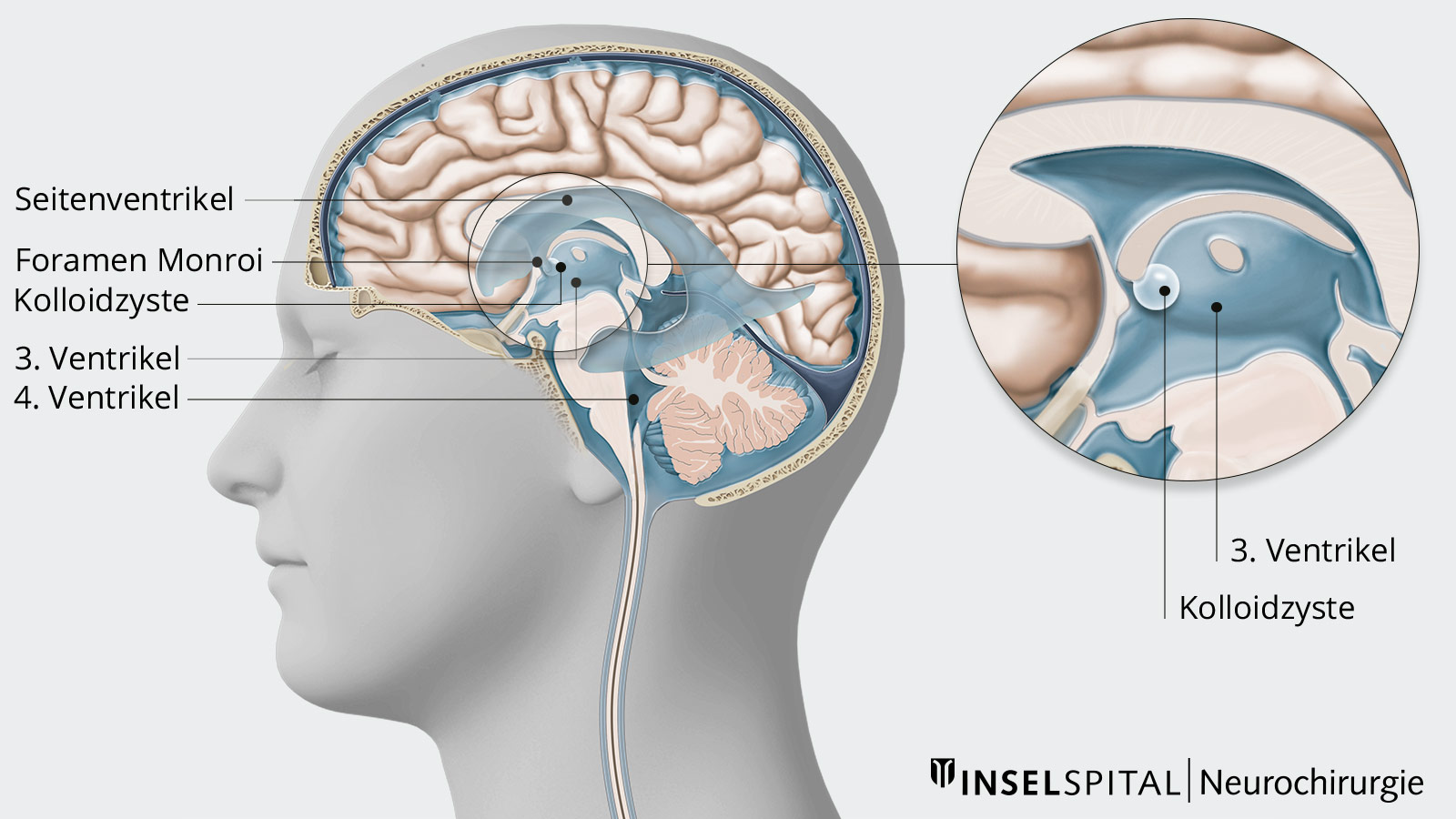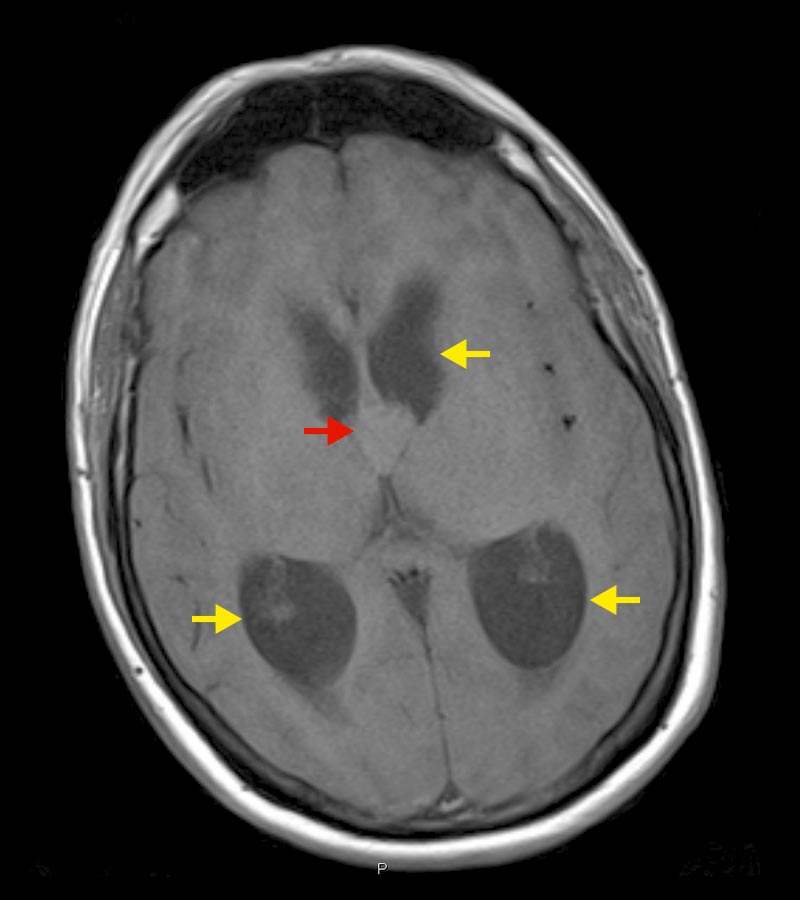A colloid cyst is a benign cyst that typically occurs in the area of the third brain ventricle and may, under certain circumstances, lead to a build-up of cerebrospinal fluid, resulting in hydrocephalus. Not every colloid cyst requires treatment. However, if the cyst causes symptoms and surgery becomes necessary, we can draw upon extensive experience at our clinic.

What is a colloid cyst?
Colloid cysts are benign cystic structures lined with an epithelial layer and containing a mucoid fluid. The accumulation of this mucoid fluid, which originates from the cells of the cyst wall, often results in gradual cyst growth as the cyst progresses.
Colloid cysts are found in the majority in the anterior superior region of the 3rd cerebral ventricle. The ventricular system is a contiguous system of cavities inside the brain filled with cerebrospinal fluid (CSF), whose 4 ventricles are connected by openings (foramina).
Colloid cysts can block the junction of both lateral ventricles to the 3rd ventricle, the so-called foramen Monro, resulting in a build-up of cerebrospinal fluid in one or, in most cases, both lateral ventricles. This CSF congestion leads to a slow increase or, if the passage is completely blocked, to a sudden and dangerous increase in intracranial pressure.
How common is a colloid cyst?
The disease is quite rare and accounts for only 0.5–1% of all intracranial space-occupying lesions. The age group between 20–50 years is most frequently affected.
What symptoms does a colloid cyst cause?
Symptoms only occur when there is a narrowing of the CSF outflow pathways. Before this, colloid cysts are asymptomatic and are often only diagnosed as an incidental finding during another examination. The most common complaints are:
- headaches
- tiredness
- nausea/vomiting
- balance problems
- visual disturbances such as blurred vision
- incontinence
- reduced ability to concentrate
- memory disorders
Less frequent are:
- double vision
- epileptic seizures
- tinnitus
Discomfort may increase slowly, subside temporarily, or even stop if the occlusion is not complete. This sometimes occurs depending on the position of the head.
Complete closure of the cerebrospinal fluid pathways
However, acute and complete occlusion of the CSF pathways results in sudden onset and rapidly increasing symptoms with a dangerous increase in intracranial pressure. A sudden increase in intracranial pressure can be acutely life-threatening, and deaths due to colloid cysts, although rare, have been described. Nevertheless, the incidence of acute neurological deterioration is low (0.8%).
What is the cause of colloid cysts?
The cysts originate from the embryonic tissue of the diencephalon. They are a developmental anomaly during embryonic development. The secretion of fluid from the epithelial cells of the cyst wall into the cyst interior causes the cyst to increase in size.
How are colloid cysts diagnosed?
Both the cyst and the mass in the foramen of Monro can be detected by computed tomography (CT). On computed tomography, cysts usually appear as bright structures that readily absorb contrast. Calcifications are rather rare.
Magnetic resonance imaging (MRI) shows the cyst and its demarcation from adjacent structures more clearly. Colloid cysts are typically iso- or hyperintense on T1-weighted images, hypointense on T2-weighted images, and hyperintense on FLAIR images. Mild contrast enhancement is possible. The extent of CSF accumulation can be determined by the width of the lateral ventricles.


What is the treatment for colloid cysts?
Not every colloid cyst increases in size and needs to be treated. Small colloid cysts that do not cause disruption or blockage of CSF circulation can be checked at regular intervals and observed using the imaging techniques mentioned above.
Cysts that significantly narrow the foramen of Monro or are already causing CSF congestion should be removed. The need for intervention in growing cysts arises in about 8.6% of all cases.
Surgery
The procedure is performed via a minimally invasive approachendoscopically or microsurgically. The ideal surgical approach is determined on a case-by-case basis based on the exact cyst location and size as well as the extent of hydrocephalus. Postoperative follow-up includes MRI monitoring to detect any recurrences in time, although these are rare.
Cyst removal can restore the flow of cerebrospinal fluid. However, some patients may experience impaired CSF reabsorption after the procedure, resulting in so-called hydrocephalus malresorptivus within days or weeks. This must be corrected by implanting a shunt.
In addition, recurrences may occur if a residue of the cyst wall remains attached to the roof of the third ventricle.
-
Greenberg MS. Handbook of Neurosurgery. Thieme; 2016:1664.
-
O’Neill AH, Gragnaniello C, Lai LT. Natural history of incidental colloid cysts of the third ventricle: A systematic review. J Clin Neurosci. 2018;53:122-126.
